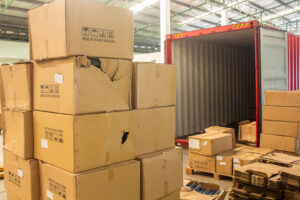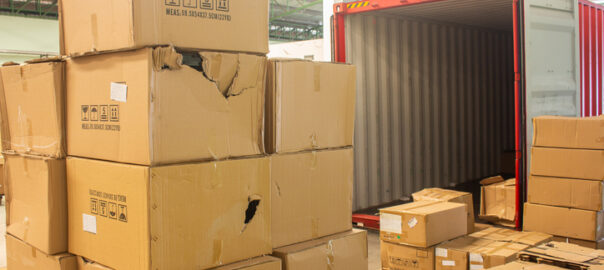As soon as a driver signs a freight bill accepting a load, the responsibility of that load falls on the driver’s shoulders until it is safely delivered to the destination. That is a lot of pressure to make sure the cargo is in good condition once it is delivered.

Cargo must not shift, leak, spill, blow, or fall during transit. Shifting cargo can result in accidents, cargo damage, and damage to the trailer or other property, not to mention personal injuries. Picking up a load is where the driver will need to take on responsibility and not rely on the shipper to confirm the cargo is secure. You should always be present for the loading of your trailer to count and examine freight for existing damage and to ensure cargo is loaded correctly.
Pre-Inspect Cargo for Damaged Freight
Often, damage to shipping cartons can come from a forklift operator moving the freight around. Check the packaging for weak cartons and pallets to ensure they are strong enough to secure the load. This will help minimize slipping or shifting.
Moving the loads from the dock floor to the trailer floor, which is often unstable, can cause the trailer to bounce during loading. All this moving tends to cause damaged freight.
Trailer stabilizing devices can reduce this tendency to bounce. Make sure the cartons or the pallets aren’t overloaded. Masonite or similar material can be placed on top of a pallet prior to stacking the cartons. This helps in securing the cargo. Make sure to use stretch wrap to secure the load to the pallet.
Loading Tips to Prevent Damage
First, you must know and recognize the condition and capacity of your truck and trailer and the forces that can cause the movement of the cargo. Before loading the cargo, make sure the trailer is designed to haul the type of cargo. Remember that high center of gravity, liquid surges, weight distribution, and improper or inadequate chains and straps can cause a load to shift. Failure to do so can cause damage to the cargo.
Types of Stacking Methods
Solid and Rigid Contents: Use interlocking stacking. Boxes are stacked in a brick-like manner, with the weight of each box partially supported by more than one box below.
Soft Fragile Contents: The column stacking method is best. A series of columns are built on a pallet with the weight supported by one box beneath.
Ensure that boxes do not hang over the edge of the pallet. Pallet overhangs can reduce box strength. The overhanging box also has an increased risk of freight damage from other shipments.
Keeping the top of your stack flat will protect your freight from being damaged by freight stacked on top.
Stabilizing the Cargo
Now that you have made sure your freight is properly stacked make sure you take the right steps to secure and protect it. How you secure your freight will determine what it is.
Dry Freight
Remember to keep it tight. Keep heavier cargo on the bottom to keep the center of gravity low. Use appropriate dunnage to fill in any gaps. One popular type of dunnage is airbags. These are inserted in the gaps and then inflated by an air pump to the proper size and pressure. Dunnage bags can prevent one of the most common causes of freight damage during transit: freight falling forward or backward. They can also brace loads and help absorb vibration.
Refrigerated cargo
Monitor the fuel and temperature settings all through transit. Make sure that adequate air is circulating during loading. Use pallets to keep the cargo tight; this will help with air circulation.
Flatbed trailer
Ensure you have enough chains that meet the North American Cargo Securement Standards. Use adequate blocking to prevent cargo movement. Check the load within the first 50 miles of your trip and often throughout it to ensure it is secure. Avoid sudden maneuvers that can cause cargo to shift.
Proper Loading and Careful Cargo Securement
Use the proper tools to help minimize shifting.
Top and bottom load-protector pads – Fill voids with airbags or corrugated sheets to help protect the top and bottom boxes in the stack. The bottom pad will prevent any boxes from falling into gaps in the pallet. The top pad will protect the top boxes from other shipments that may be loaded on top. It will also help to evenly distribute the weight of any freight that is loaded on top.
Use banding or load locks to secure the load to the pallet.
Banding works best with Irregularly shaped loads. Keep the banding as close as possible to the freight to avoid breakage.
Load locks prevent the load from shifting from front to back.
Stretch wrap or shrink wrap should be used to keep all the boxes together and stabilized on the pallet. For proper security, the stretch wrap should overlap by 3” over the top of the pallet’s base and overlap by 3’’ at the top of the load.
Corner protectors help prevent damage to the edge of cargo.
Remember, most roads slope from the center to the edges to drain water off the road. As you change lanes, your load is subject to the forces of gravity and those sloping roads. If your cargo is secure, you should not have too much shipping freight. The less cargo damage, the happier the customer.


